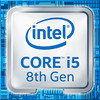Intel Core i5-8500 vs Intel Core i3-8109U
Intel Core i5-8500
► remove from comparison
The Intel Core i5-8500 is a mid-range 6-core CPU. The processor belongs to the Coffee Lake generation and was presented in April 2018. It does not support Hyper-Threading, which means it can run six threads simultaneously. The base clock rate is 3 GHz and the CPU can speed up to 4.1 GHz under high load. Despite belonging to the new generation of CPUs, the Core i5-8500 is manufactured in an improved 14nm process.
Performance
The processor offers a strong performance increase compared to the Core i5-7500 due to its two additional cores. Single-core performance has not improved significantly compared to its Kaby Lake predecessor. As a mid-range model, the Core i5-8500 should be suitable for demanding games and programs.
Graphics
The integrated Intel UHD Graphics 630 iGPU is supposed to offer higher performance as its clock rate has been increased by 50-100 MHz. The build is identical to that of the Intel HD Graphics 630. We do expect a performance improvement, but as a low-end solution it will probably only display current games smoothly at reduced details - if at all.
Power Consumption
Intel specifies the TDP with 65 watts. Therefore, well-dimensioned cooling systems should easily manage to deal with the created heat. We expect increased efficiency due to the higher performance.
Intel Core i3-8109U
► remove from comparisonThe Intel Core i3-8109U is a dual-core SoC for notebooks based on the Coffee Lake architecture and was announced in April 2018. Compared to its predecessor Core i3-7167U, the CPU now supports Turbo boost with up to 3.6 GHz. Thanks to Hyperthreading the CPU can execute up to 4 threads simultaneously. It is also equipped with an Intel Iris Plus Graphics 655 GPU with 128 MB eDRAM (but with 300 - 1050 MHz it is the slowest Iris Plus), a dual-channel memory controller (DDR4) as well as VP9 and H.265 video decoding as well as encoding. The chip is still manufactured in a 14nm++ process (3rd generation) with FinFET transistors.
Architecture
Intel basically uses the same micro architecture compared to Kaby Lake, so the per-MHz performance does not differ. The manufacturer only reworked the Speed Shift technology for faster dynamic adjustments of voltages and clocks, and the improved 14nm process allows much higher frequencies combined with better efficiency than before.
Performance
Thanks to the Turbo Boost, the processor performance should be a bit above the old Core i7-7500U (max. 3.5 GHz, 15 Watt). Therefore the Core i3-8109U should be fine for most applications. Some games however already need four real cores for optimal performance (paired with a dedicated GPU e.g.).
Graphics
The integrated Intel Iris Plus 655 Graphics is the GT3e model of the Kaby Lake GPU (Intel Gen. 9.5). It has 48 Execution Units running at 300-1050 MHz and the performance is comparable to a GeForce 930M or 940MX thanks to fast eDRAM cache. However, there aren't any significant improvements compared to the old Iris Plus 650, so modern games can often not be played smoothly or only at the lowest or medium settings, respectively.
Contrary to Skylake, Kaby lake now also supports H.265/HEVC Main 10 with a 10-bit color depth as well as Google's VP9 codec. The dual-core Kaby Lake processors announced in January should also support HDCP 2.2.
Power Consumption
The chip is manufactured in an improved 14nm process (14nm++, 3rd generation of 14nm) with FinFET transistors, which improves the efficiency even further. Intel specifies the TDP with 28 Watts, which can be reduced to 23 Watts (cTDP Down) depending on the usage scenario. The TDP is pretty high compared to the common 15-Watt TDP for quad-core processors, but allows a better utilization of CPU and GPU Turbo.
| Model | Intel Core i5-8500 | Intel Core i3-8109U | ||||||||||||||||||||||||||||||||||||||||||||||||||||||||
| Codename | Coffee Lake-S | Coffee Lake-U | ||||||||||||||||||||||||||||||||||||||||||||||||||||||||
| Series | Intel Coffee Lake | Intel Coffee Lake | ||||||||||||||||||||||||||||||||||||||||||||||||||||||||
| Series: Coffee Lake Coffee Lake-U |
|
| ||||||||||||||||||||||||||||||||||||||||||||||||||||||||
| Clock | 3000 - 4100 MHz | 3000 - 3600 MHz | ||||||||||||||||||||||||||||||||||||||||||||||||||||||||
| L1 Cache | 384 KB | 128 KB | ||||||||||||||||||||||||||||||||||||||||||||||||||||||||
| L2 Cache | 1.5 MB | 512 KB | ||||||||||||||||||||||||||||||||||||||||||||||||||||||||
| L3 Cache | 9 MB | 4 MB | ||||||||||||||||||||||||||||||||||||||||||||||||||||||||
| Cores / Threads | 6 / 6 | 2 / 4 | ||||||||||||||||||||||||||||||||||||||||||||||||||||||||
| TDP | 65 Watt | 28 Watt | ||||||||||||||||||||||||||||||||||||||||||||||||||||||||
| Technology | 14 nm | 14 nm | ||||||||||||||||||||||||||||||||||||||||||||||||||||||||
| max. Temp. | 100 °C | 100 °C | ||||||||||||||||||||||||||||||||||||||||||||||||||||||||
| Socket | FCLGA1151 | FCBGA1528 | ||||||||||||||||||||||||||||||||||||||||||||||||||||||||
| Features | Dual-Channel DDR3(L)-1600/DDR4-2666 Memory Controller, HyperThreading, AVX, AVX2, AES-NI, TSX-NI, Quick Sync, Virtualization, vPro | Dual-Channel DDR4 Memory Controller, HyperThreading, AVX, AVX2, Quick Sync, Virtualization, AES-NI, Intel SSE4.1, Intel SSE 4.2 | ||||||||||||||||||||||||||||||||||||||||||||||||||||||||
| iGPU | Intel UHD Graphics 630 (350 - 1100 MHz) | Intel Iris Plus Graphics 655 (300 - 1050 MHz) | ||||||||||||||||||||||||||||||||||||||||||||||||||||||||
| Architecture | x86 | x86 | ||||||||||||||||||||||||||||||||||||||||||||||||||||||||
| $202 U.S. | ||||||||||||||||||||||||||||||||||||||||||||||||||||||||||
| Announced | ||||||||||||||||||||||||||||||||||||||||||||||||||||||||||
| Manufacturer | ark.intel.com | ark.intel.com |
Benchmarks
Average Benchmarks Intel Core i5-8500 → 100% n=9
Average Benchmarks Intel Core i3-8109U → 52% n=9
* Smaller numbers mean a higher performance
1 This benchmark is not used for the average calculation













